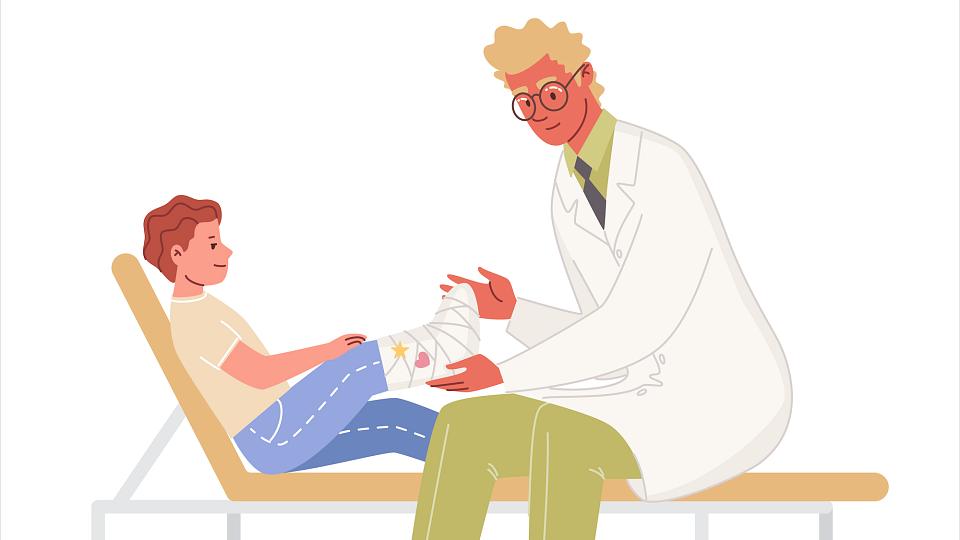
Interviewer: You're wondering if you should let you kids play contact sports that could lead to concussion injury. What are some of the things that you should discuss and think about? We'll find out from concussion expert Dr. Colby Hansen next on The Scope.
Announcer: Medical news and research from University of Utah physicians, and specialists you can use for a happier and healthier life. You're listening to The Scope.
Should I Let My Kid Play Contact Sports?
Interviewer: Dr. Colby Hansen is a concussion expert at University of Utah Orthopedic Center's concussion clinic. Ultimately, I think the question that every parent would want to know given the stories and a lot of talk about concussions in the media, is it still safe or is it safe for my kids to play sports? I suppose you get that question a lot know a days.
Dr. Hansen: I do. I would say, yes, it's totally appropriate for kids to play sports.
Interviewer: Even football.
Dr. Hansen: Yes.
Are Some Sports Safer Than Others?
Interviewer: Which seems to be . . . is that the highest risk of a concussion, that sport?
Dr. Hansen: Football is right up there. There are others that are near it - hockey, things like rugby, soccer not too far behind, wrestling.
Interviewer: So it's still safe in, your opinion, for kids to play sports.
Dr. Hansen: I think you have to ask yourself the question, "What is the value of my kid in playing sports?" which I think are numerous.
Interviewer: Maybe basketball would be a better option than football? Where should a parent stand on that?
Football & Concussion Safety
Dr. Hansen: If we talk about football specifically. Yes, football has some risk to it. Might there be an appropriate age where it's best to start to engaging in football and maybe a younger age where they shouldn't? I don't know. I am not really going to comment on that or try to pretend to be the expert or sounding board for that.
Interviewer: Is there research going on right now or research that would point to an answer to that question?
Dr. Hansen: Well, I know that some groups are interested in taking measures to reduce the number of impacts that people sustain playing a contact sport, like football. There are visible things that people who watch football might see as being measures in that regard - reducing the number of kick-off plays, increasing the number of touch-backs that occur, rules to prevent helmet-to-helmet or targeting types of collisions.
In the background there are lots of efforts to try to educate athletes, and coaches in proper tackling techniques. There are even rules now that are coming down limiting the number of contact practices in full pads, in full gear, to reduce the amount of contact that's sustained over the course of the season.
The Risks of Repeated Head Injury
Those are, I think, appropriate measures. I don't know that we know exactly what's an acceptable amount of collisions to sustain. I think a lot of it eventually comes back to educating coaches, educating parents, educating athletes.
Where I see, perhaps, the biggest problem is when the initial injury may occur and it's not recognized. Instead of taking the kid out of play and observing them or even just making them sit out the rest of that practice or game, there is a tendency to, I think, brush it off. Whether it's on the part of the coach or the athlete, I think, sometimes both at fault, and just rush them out there, and say, "You're okay, let's go at it." That's where you're at risk.
Interviewer: Is that one of the most dangerous things that can happen? You sustain a concussion type head injury, and you go get one immediately right after that?
Dr. Hansen: Exactly.
Interviewer: That's where problems really start arising.
Keep it Safe
Dr. Hansen: Yeah. There's a saying that goes around in the concussion world, "When in doubt, sit him out." I think that is totally appropriate, there's nothing wrong with that. Is it, perhaps, on the conservative side? Sure. But I think it may well prevent some of these other complications that arise when it's not recognized and then what you have is a situation where kids are, perhaps, sustaining multiple, subsequent collisions over the course of a game or perhaps a few practices. It starts to add up.
Lasting Effects of Repeated Head Injuries
Interviewer: Let's go down that path for a second. Are there lasting effects that can occur from those multiple sustained injuries if enough recovery time in between doesn't happen?
Dr. Hansen: I would say yes. From animal model data, and what we see from following players over time in some studies that have done that over the course of a season, if not given adequate recovery time, I think that certainly is a huge risk factor, maybe one of the biggest, for prolonged problems and symptoms that, unfortunately, in a few instances, may not go away.
How to Play Safely
Interviewer: What's your advice to a parent that has a kid in a sport that can lead to concussion or multiple concussions? Do you have children?
Dr. Hansen: I do.
Interviewer: And as a parent and an expert on concussions what's your strategy on this? What's your thought?
Dr. Hansen: My kids aren't, frankly, interested too much in those types of sports.
Interviewer: Does that make you a little happy on some level?
Dr. Hansen: So that takes some of the pressure off.
Interviewer: Nobody got a concussion in band.
Get Proper Safety Gear
Dr. Hansen: Exactly. I would say it's appropriate to allow kids to play in sanctioned sports, if there are sanctioned leagues and things out there. I think it's appropriate to make sure that the kids have the correct and correct fitting safety equipment. I think a lot of it comes back to the education piece. If an accident occurs, which there is often times not much you can do to prevent an accident, that you manage that appropriately.
Seek Medical Attention for Sports Injuries
Now there gets to be a point where if somebody sustains a number of injuries where you many have to re-think that. Unfortunately, we don't have the magic answer to what's acceptable. How many is too many? We frankly don't know the answer to that question. It should raise some concern if you're starting to have repeat injuries and cause you to re-think that whole issue.
That too, I think comes back to where it may be helpful to talk to a specialist in this area to help you think through those types of questions. Even understanding that even we may not have a definitive answer based on absolute proven scientific research.
Interviewer: And that's something you do at the concussion clinic here at University of Utah Health Care. You'll have consultations, you do some base-line testing, I saw. You consult with sports teams, that sort of thing to help. So, information, knowledge really the most powerful thing right now.
Dr. Hansen: Yeah, I think that's a huge, huge part to what we do. When is it okay to get back to playing? What's appropriate to kind of think about or do we need to maybe think about maybe switching sports altogether? Or any number of things.
Announcer: TheScopeRadio.com is University of Utah's Health Sciences Radio. If you like what you heard be sure to get our latest content by following us on Facebook. Just click on the Facebook icon at TheScopeRadio.com.
Learn More About Pediatric Sports Medicine & Orthopedics
Seven Questions for a Pediatric Orthopedic Surgeon
On this episode of Seven Questions for a Specialist, pediatric orthopedic surgeon Joshua Speirs, MD, shares insights into the typical diagnoses he encounters, debunks common misconceptions about pediatric orthopedics...





